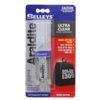Mark2000
Active Member
I'm trying to get some .5mm fibre optics into a tight space that needs to be glued shut in close proximity on either side. Both times I've sealed up the model it appears that the styrene glue's fumes or plastic with the glue in it touched the fibres and melted and snapped them. The area is a tight fit that really needs a chemical bond to shut it, otherwise there with be ridiculous gaps, especially since there's a lot of scar tissue now from cutting the seam open twice. What can I do to protect the fibre? Or is there another glue I can use? CA seems to melt fibres too. Epoxy makes a mess, especially on such a small scale. White glue would never hold.

